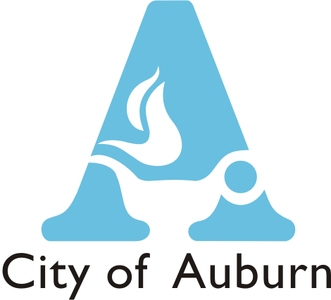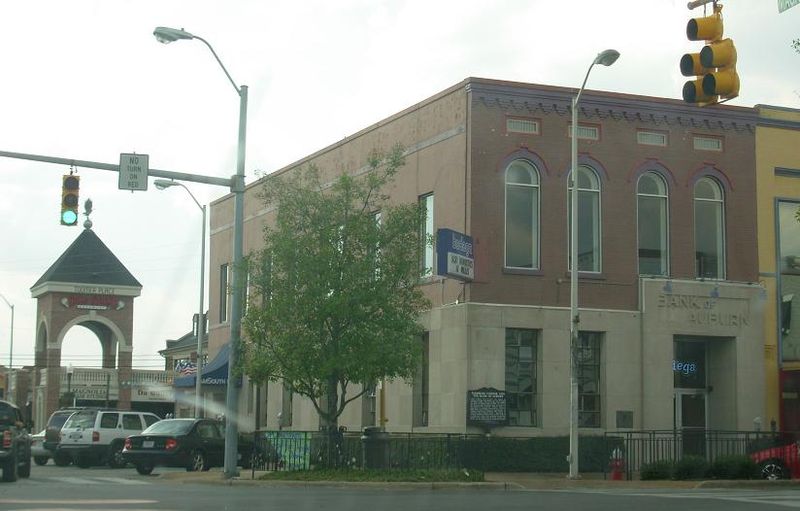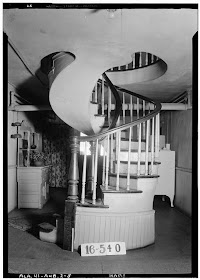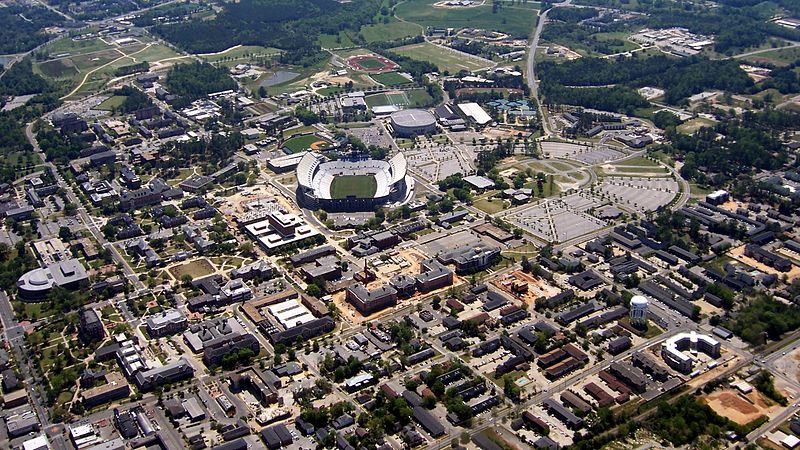
Auburn is a city in Lee County, Alabama, United States. It is the largest city in eastern Alabama with a 2007 population of 54,348. It is the principal city of the Auburn Metropolitan Area, a MSA with a population of 130,516 which, along with the Columbus, Georgia-Alabama MSA and the Tuskegee, Alabama Micropolitan Statistical Area, comprises the greater Columbus-Auburn-Opelika, Georgia-Alabama Combined Statistical Area a region home to approximately 500,000 residents.

Auburn is a college town and is the home of Auburn University. Auburn has been marked in recent years by rapid growth, and is currently the fastest growing metropolitan area in Alabama and the nineteenth-fastest growing metro area in the United States since 1990. The city's unofficial nickname is The Loveliest Village On The Plains, taken from a line in the poem The Deserted Village by Oliver Goldsmith: "Sweet Auburn! loveliest village of the plain . . ."

Drake-Samford House, 449 North Gay Street, Auburn, Lee County, AL
Nickname(s): The Loveliest Village on the Plains
History

Toomer's Corner; Downtown Auburn, Alabama by night.
Inhabited in antiquity by the Creek, the land on which Auburn sits was opened to settlement in 1832 with the Treaty of Cusseta. The first settlers arrived in the winter of 1836 from Harris County, Georgia. These settlers, led by Judge John J. Harper, intended to build a town that would be the religious and educational center for the area.
Auburn was incorporated on February 2, 1839, covering an area of 2 square miles (5.6 km²). By that time, Methodist and Baptist churches had been established, and a school had been built and had come into operation. In the mid-1840s, separate academies for boys and girls were established in addition to the primary school. This concentration of educational institutions led to a rapid influx of families from the planter class into Auburn in the 1840's and 1850's. By 1858, of the roughly 1,000 free residents of Auburn, some 500 were students.

Scott-Yarbrough House, 101 Debardeleben Street, Auburn, Lee County, AL
In 1856, the state legislature chartered a Methodist college, the East Alabama Male College in Auburn. This college, now Auburn University, opened its doors in 1859, offering a classical and liberal education.
With the advent of the Civil War in 1861, Auburn quickly emptied. All of the schools closed, and most businesses shuttered. Auburn was the site of a hospital for Texan Confederate soldiers, but only saw direct combat with the raids of Rousseau in 1864 and Wilson in 1865.

One of Auburn's many biking and walking trails.
After the Civil War, Auburn's economy entered a prolonged depression that would last the remainder of the century. Public schools did not reopen until the mid-1870s, and most businesses remained closed. A series of fires in the 1860s and 1870s gutted the downtown area. East Alabama Male College was turned over to the state in 1872, and with funds from the federal Morrill Act was renamed Alabama Agricultural and Mechanical College with a new mission as a land grant college. Passage of the Hatch Act in 1887 allowed for expansion of agricultural research facilities on campus.
In 1892, the college became the first four-year college in Alabama to admit women. This, combined with increased interest in scientific agriculture and engineering and new funding from business licenses, allowed the city to start expanding again. By 1910, Auburn's population had returned to its antebellum level. SIAA Conference championships won by the Auburn college's football team brought attention and support to Auburn, and helped fill the city's coffers.
 Moore-Whatley House, Moore's Mill Road, Auburn vicinity, Lee County, AL
Moore-Whatley House, Moore's Mill Road, Auburn vicinity, Lee County, ALFortunes were quickly reversed with the collapse of cotton prices in the early 1920's and the subsequent Great Depression a decade later. Due to these events, the state government became unable to fund the college, and—as Auburn's economy was completely derived from the college—residents were forced into a barter economy to support themselves.
Money began to flow into Auburn again with America's entry into World War II. Auburn's campus was turned into a training ground for technical specialists in the armed forces. After the war, Auburn was flooded by soldiers returning to school on the G.I. Bill.
 Front View
Front View  Rear View
Rear View Slave Kitchen Frazier-Brown House, Shelton Mill Road, Auburn vicinity, Lee County, AL
Slave Kitchen Frazier-Brown House, Shelton Mill Road, Auburn vicinity, Lee County, ALPrimarily due to this influx of students, Auburn began a period of growth that lasted through the 1950's and 1960's. A considerable amount of residential and business construction pushed Auburn's growth outside of the original boundaries of the city, leading to a series of large annexations which expanded Auburn to nearly 24square miles (63 km²). Construction of Interstate 85 beginning in 1957 connected Auburn to the major cities of the state. This allowed for Auburn University (renamed in 1960) to schedule more home football games in Auburn rather than in larger cities, creating a strong tourism component in Auburn's economy.

 Cauthen House, East Drake Avenue, Auburn, Lee County, AL
Cauthen House, East Drake Avenue, Auburn, Lee County, ALGrowth slowed somewhat in the 1970's, and a series of budget cuts made it clear that Auburn's sole economic reliance on Auburn University put the city in a tenuous position.

Downtown Auburn, Alabama.
Backlash against what was seen as an ineffectual city council led to the election of Jan Dempsey as mayor in 1982 and the removal of the previous city government system in favor of a council-manager system. With a new government in place, the city began aggressively pursuing industry, leading to a nearly 1,200% increase in the number of industrial jobs over the next twenty years. As public satisfaction with the city administration reached record levels, Auburn began very rapid residential growth.
A series of reports in the 1980's and 1990's ranking the Auburn public school system among the top in the state and nation convinced thousands of new residents to move to Auburn over the past 25 years. Between 1980 and 2003, Auburn's population grew by 65%, and Auburn's economy expanded by 220%. With growth came issues of urban sprawl, which has become the primary political issue in Auburn at the turn of the 21st century.

 Meadows House, 342 North College Street, Auburn, Lee County, AL
Meadows House, 342 North College Street, Auburn, Lee County, ALLaw and Government

City map of Auburn.
Auburn has a council-manager government led by an eight-member city council, a mayor, and an appointed city manager.
 Auburn City Hall
Auburn City HallThe city council acts as a legislative body of the city, passing laws and regulations and appointing citizens to the city's various boards, including the Auburn City Board of Education. Each member of the city council is elected for a four-year term from one of eight geographic wards. Ward 1 is designed to ensure African-American representation on the council.
Members of the current Auburn City Council are:
Ward 1 - Arthur L. Dowdell, Sr.
Ward 2 - Shelia Eckman
Ward 3 - Thomas W. Worden
Ward 4 - Brent Beard
Ward 5 - Robin Kelley
Ward 6 - Dick Phelan
Ward 7 - Gene Dulaney
Ward 8 - Bob Norman
The mayor of Auburn is elected in the city at-large to a four year term. The duties of the mayor are, per State Code: ceremonial, to serve as the Governor's contact in the event of an emergeny and to conduct Council meetings. The Mayor has no administrative duties, as the City Manager serves as the CEO. As such, the position of mayor in Auburn is primarily symbolic. The current mayor of Auburn is Bill Ham, Jr.
The day-to-day operations of Auburn are run by the City Manager. The City Manager is appointed by and serves at the leisure of the City Council. The City Manager is responsible for the appointment and dismissal of all department heads, advises the council on policy matters, and creates and administers the city budget. The current City Manager of Auburn is Charlie Duggan.
Geography

A creek flowing through Chewacla State Park in Auburn.
The city of Auburn lies in western Lee County and is bordered by the city of Opelika to the northeast and by Chambers County to the north. The city stretches south to the Macon County line in the southwest.





 Holliday-Carey House, 360 North College Street, Auburn, Lee County, AL
Holliday-Carey House, 360 North College Street, Auburn, Lee County, ALAuburn sits on the fall line at the juncture of the piedmont plateau and the coastal plain. Portions of Auburn also include the southernmost exposure of rocks indicating the Appalachian orogeny--as such, the last foothill of the Appalachian Mountains lies in Chewacla State Park in southern Auburn. As a result of these three varied physical environments, Auburn has an extremely diverse geology.

Samford Hall, on the Auburn University campus.
The southwest and west regions of the city on the plateau are marked by rolling plains and savannahs, with the undeveloped portion primarily being used for cattle grazing and ranching. South of this region sits the coastal plain, with sandy soil and pine forest. Parts of north Auburn have much more rugged topographies, with thick forests in high hills and deep hollows of the type common to parts of eastern Tennessee. The region surrounded by Chewacla Park in the south of the city contains sharp peaks and sudden drops of elevation as the 3.5 billion year-old rock of the Appalachians meets the coastal plain.


 McElhaney House, 135 North College Street, Auburn, Lee County, AL
McElhaney House, 135 North College Street, Auburn, Lee County, ALAuburn sits near the divide between the Chattahoochee and Tallapoosa River watersheds. Auburn is drained by three main creek systems: in the south, by the Chewacla/Opintlocco Creek system; in the north, by the Saugahatchee Creek system; and in the extreme northern reaches of Auburn by Sandy Creek. The dividing line between the Chewacla and Saugahatchee watersheds roughly follows railroad line east-west through the center of town.
Climate
Auburn has a typically Southern climate marked by mild winters, hot, muggy summers, and moderate autumns and springs. Due to Auburn's position near the Gulf of Mexico, the city receives a significant amount of rainfall--on average, 52.6 inches (1340 mm) per year—though there is a distinct dry season in the late summer and early fall. Severe storm activity is common from the late winter through early summer. Owing to its proximity to the Gulf, Auburn is also subject to fringe effects from tropical storms and hurricanes in the summer and fall. Hurricanes Opal in 1995 and Ivan in 2004 are among two of the most notable tropical systems to affect the Auburn area in recent memory, bringing torrential rains and high winds.
Economy

Samford Hall, on the Auburn University campus.
Auburn's economy is centered around Auburn University and providing university-affiliated services. Auburn University employs 4,300 people, which is roughly one-quarter of the city's total workforce. In addition, 2,400 Auburnites are employed by the federal and state government in positions which are generally connected with the university. Some 8,500 are employed in service sector jobs.
Auburn's industrial base is built around mid-sized, high tech manufacturing and research firms. Auburn has four technology parks where main areas of industrial focus are on the manufacture of small engines, automotive wheels, fuel cells, plastic injection technology, and vehicle armor. The 156 acre (0.6 km²) Auburn University Research Park is currently under construction and will be anchored by a firm which specializes in research in high-resolution, dark field optical microscopy. Overall, the manufacturing sector accounts for some 5,000 jobs in Auburn.
Education
Auburn, as a college town, is largely driven by the influence of education. Auburn has one post-secondary school, Auburn University, which has an enrollment of 23,000. Auburn University is a Land-grant university with traditionally strong programs in business, engineering, agriculture, and veterinary medicine. The university is largely focused on undergraduate education, with a graduate enrollment of only 4,000. Auburn University is a research institution, with primary areas of research focus including wireless engineering, molecular biosciences, transportation, aquaculture, and forest sustainability.

Auburn University, Langdon Hall, College Street, Auburn, Lee County, AL
Auburn is also home to several research centers, including the Ludwig von Mises Institute.
 Auburn Public Library
Auburn Public LibraryAuburn's public school system includes one kindergarten, six elementary schools, one middle school, one junior high school, and one high school. Auburn's school system has repeatedly been ranked among the top public school systems in the state and nation. Auburn City Schools has been ranked among the top 100 school districts in the United States by Parenting magazine and as the best educational value in the Southeast by the Wall Street Journal. Auburn's Early Education Center has specialized programs for autism education, has been recognized as a national Blue Ribbon school, and is an Intel and Scholastic School of Distinction. Auburn High School has strong International Baccalaureate and music programs, and was ranked in 2006 by Newsweek as the top non-magnet public high school in Alabama, and one of the top 30 in the United States.
 Auburn High School Library
Auburn High School LibraryTransportation
Opelika Robert G. Pitts Airport
Auburn is located in the southeastern part of Alabama and is accessible by Interstate 85, US 29, and US 280. The city also has a general aviation airport, the Auburn-Opelika Robert G. Pitts Airport (AUO), which is 2 miles (3.2 km) east of downtown Auburn. The major commercial airports closest to Auburn are the Hartsfield-Jackson Atlanta International Airport (ATL) (Atlanta) and the Birmingham-Shuttlesworth International Airport (BHM) (Birmingham). Each of these airports is within 2 hours driving distance from Auburn and together they offer air service to most of the world's major airports. There are also two regional airports close to Auburn: Montgomery Regional Airport (MGM) (Montgomery) and the Columbus Metropolitan Airport (CSG) (Columbus).
Express 85 provides daily ground transportation trips between the Atlanta airport and Auburn. EagleTown Taxi,Twin City Taxi and Tiger Taxi provides both local taxi service and flat-rate transportation service to other cities. Auburn is one of the most bicycle-friendly small towns in the country and received an award for being a bike friendly town from the
Auburn University also provides students with the Tiger Transit bus system, which shuttles students and faculty around campus and to area apartment complexes.
Arts, culture, and recreation
Auburn's Jule Collins Smith Museum of Fine Art.
Auburn is the home to the Jule Collins Smith Museum of Fine Art. The Smith Museum maintains a collection of primarily 19th and 20th century American and European art. The museum's exhibits include the Advancing American Art Collection, consisting of 36 works by mid-20th century American artists including Jacob Lawrence, Ben Shahn, and Georgia O'Keeffe, a collection of engravings by naturalist John James Audubon, and works by Dali, Chagall, Renoir, Picasso, and Matisse. Major sculptural works at the museum include a collection of Tibetan bronzes, Jean Woodham's Spinoff, and Dale Chihuly's Amber Luster Chandelier.
Also in Auburn is the Telfair Peet Theatre, which performs a series of plays and musicals each year. The Auburn Community Orchestra, as well as the bands of Auburn University and the Auburn High School Honors Band perform dozens of yearly concerts, including a series of outdoor concerts in the fall at Kiesel Park. Other musical series in Auburn include that of the Auburn Knights Orchestra, a big band jazz orchestra, and the Sundilla Acoustic Concert Series. The theatre is rumoured to be haunted by a ghost named Sydney, who the theatre department appeases before every performance with a package of Reese's Pieces.
Auburn is also home to Auburn Area Community Theater (AACT), a community-based organization that puts on three productions a year, including a spring children's show. All performances are rehearsed and performed at the Jan Dempsey Community Arts Center.
There are a number of dance schools in Auburn that give classes in a variety of dance styles, such as ballet, jazz, hip-hop, ballroom, and even Irish dancing, which is supported by the Drake School of Irish Dance.
The Quilts Of Gee's Bend
Recreational opportunities in Auburn include 16 parks, highlighted by Chewacla State Park, a 700acre (2.8 km²) park in the Appalachian foothills, Kiesel Park, a 200 acre (0.8 km²) "passive" park with numerous trails, and the Louise Kreher Forest Ecology Preserve. The Donald E. Davis Arboretum showcases 150 different tree species native to Alabama and the Southeast. Auburn is also ringed by miles of multi-use trails and several lakes.
The Life Of Samuel "Sambo" Mockbee
Sports
Auburn has no professional sports teams, but nonetheless has a vibrant sports culture due to the presence of Auburn University's NCAA Division I athletic squads. Auburn University football in particular is a major force in Auburn's culture and economy. When Auburn University has home football games in the fall, the city often sees over 100,000 visitors, and the yearly economic impact is measured at nearly $100million. While other sports do not attract as many tourists to Auburn, the university's 17 varsity sports offer citizens a variety of other opportunities for viewing competition at virtually the highest level.
Home football games particularly change the face of Auburn for several weekends a year. Tens of thousands of fans flood the campus hours—sometimes days—before the game to tailgate, creating a festival-like atmosphere throughout the weekend. Football games in Auburn are played in 87,451 seat Jordan-Hare Stadium, which sits on the main campus, just a few blocks from downtown.
Beard-Eaves-Memorial_Coliseum
Basketball is played at 10,500 seat Beard-Eaves-Memorial Coliseum, while baseball games are held at 4,096 seat Plainsman Park, which was named the top collegiate ballpark in the nation by Baseball America in 2003. One of Auburn's most competitive sports is the swimming program, which has won seven of the last nine NCAA national championships including the last five straight and 11 consecutive SEC men's championships. Also, the women's program have won five NCAA national titles and four SEC championships. The teams compete at the James E. Martin Aquatics Center. More Olympic swimmers have come from Auburn's swimming program than any other university swimming program.
The Auburn Metro Area is home to 146 holes of golf at six courses, and has played host to several professional and amateur golf tournaments. Auburn Links was rated as one of the top three new courses in the nation when it opened in 1996, and the Robert Trent Jones-designed Grand National course is often cited as one of the top public courses in the nation. Because of this, in 2005, the Auburn Metro Area was ranked number 1 in the United States for golf by Golf Digest.
In the 2008 Beijing Olympics, 19 medals were won by current, former or incoming Auburn students, ranking it higher than Spain, Canada, the Netherlands, Brazil, Kenya, Poland, Hungary and Norway.
Notable Auburnites
Auburn has had many notable citizens in its 170-year history, including Nobel Prize winners, world-class architects, artists, governors, generals and admirals, and professional athletes.
Suburbs and Outlying Communities
Opelika, Alabama
Loachapoka, Alabama
Waverly, Alabama
Beauregard, Alabama
Beulah, Alabama
Gold Hill, Alabama
Bee Hive, Alabama
The Bottle, Alabama
Notasulga, Alabama
Auburn in fiction
- The fictional G.I. Joe character, Beach Head, was from Auburn.
- The book Big Fish: A Novel of Mythic Proportions by Daniel Wallace, and its derivative movie, Tim Burton's Big Fish, were both in part set in Auburn, though the movie was not filmed in Auburn.
- Auburn received mentions in the 1960 film Ocean's Eleven and 1971's Brian's Song.
- Harper Lee mentions Auburn in To Kill a Mockingbird.
- Anne Rivers Siddons, an Auburn University alumna, portrayed a fictionalized Auburn campus and students in Heartbreak Hotel.
- Caroline Ivey's characters visit Auburn in her novel Family.
- Jennifer S. Davis mentions Auburn in her short story collection Her Kind of Want.
- Ann B. Pearson, Auburn University graduate and the granddaughter of one of that school's presidents, fictionalized Auburn in the mystery books she wrote.
- The fictional veterinarian, Dr. Pharamond (Fair) Haristeen, in the mystery series written by Rita Mae Brown and Sneaky Pie Brown, graduated from Auburn University's veterinary school in Auburn.
- A skit on the popular sketch comedy show Saturday Night Live featured an opening song mentioning "the lights of Auburn, Alabama."
- Pepper Rodgers's novel Fourth and Long Gone is largely set in a college town based on Auburn.
- John Travolta plays Bobby Long, a former Auburn University English professor, in 2004's A Love Song for Bobby Long. Long's protégé and former Auburn University teaching assistant is a writer named Lawson Pines, played by Gabriel Macht.
- In the video game Tom Clancy's Splinter Cell: Double Agent, one of the main villain's profiles states that he was a football player at Auburn University.
- In the 1976 movie Stay Hungry, lead character Craig 'Buck' Blake (played by Jeff Bridges) says he is a scatback for the Auburn University football team.
- On multiple episodes of How I Met Your Mother, Marshall Eriksen (played by Jason Segel) can be seen wearing an Auburn University t-shirt.
- The children's chapter book Samantha Loses the Box Turtle is set in Auburn, AL and features a turtle that resides at the Louise Kreher Forest Ecology Preserve in Auburn.
Click Here For The Web Site Of Auburn, AL